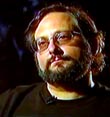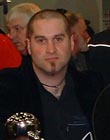|
|
 
|
|
Author
|
Topic: Cinemeccanica V4 speed problem
|
Jeff Joseph
Expert Film Handler

Posts: 131
From: Palmdale, CA, USA
Registered: Jun 2000
|
 posted 07-05-2003 01:39 AM
posted 07-05-2003 01:39 AM





Help!
One of my motors burned out. I ordered a new one from Cinemeccanica. It arrived; we installed it. And it's too fast.
Further inspection reveals the following facts:
The old motor was 1760 RPM; the new one is 1800 (so now I have one projector with an old motor and one with a new one). They no longer make the 1760 motor, and since I have to have identical motors (we are running 3-D), I ordered another 1800 RPM motor, which we will install tomorrow.
Today, I made a roll of exactly 900 feet (10 minutes). On the projector with the old motor, it lasts 9:47 And on the new one, around 9:39. So this shows that I was running too fast in the first place, and now with the new motors, I'm running still faster.
We are running 110 VAC, using big capacitors to simulate 3-phase (the projectors came to me this way 10 years ago). The motors are designed to be run that way, OR by running 3-phase at 208 volts.
So: The way I look at it... I've always been running a little fast and didn't realize it. Why would Cinemeccanica make a machine that ran too fast in the first place? And... how do I slow the projectors down? Cinemeccanica says I can add a resistor in series with the motor power supply and this will slow them properly... but should I be changing the drive gear or am I missing something or ??
I'm puzzled as to why it was fast in the first place, and now that I have a faster motor, what is the correct thing to do?
Thanks,
Jeff Joseph
SabuCat Productions
| IP: Logged
|
|
|
|
|
|
|
|
|
|
|
|
John Hawkinson
Film God

Posts: 2273
From: Cambridge, MA, USA
Registered: Feb 2002
|
 posted 07-05-2003 11:03 AM
posted 07-05-2003 11:03 AM




Some observations; not all necessarily so relevent to Jeff.
1. Motors are not always what the nameplate says they are. Since the fps:rpm ratio in your case looks about the same, you're probably good. General-purpose motors may vary up to 5% from the nameplate, motors purchased from a projector vendor should be far better. Though our Bauer U4s have motors that claim 1700rpm on the nameplate and actually run at 1783rpm (I think this is a bizarre anomaly).
2. You can definitely hear the difference at 24.9fps, and people can also see it. Generally only either people familiar with the material, or those with perfect pitch. But correcting the speed down to 24.0fps is worth doing.
3. Gordon's explanation of motors is a bit misleading. For single-phase non-synchronous motors (which is most of what you'll find in the US, though not what Jeff has), motors have a characteristic called "slip", which is the difference (usually as a percentage) between the magnetic field rotation and the physical rotation of the motor, and it is generally a few percent. For instance, a 4% slip motor might run at 1728rpm (1725rpm) instead of 1800rpm. The slip is what makes the motor run...
4. I would be a little skeptical that simply adding a resistance is sufficient to slow down the motor, but maybe I'm missing something important about running 3-phase motors off of single-phase power...
--jhawk
| IP: Logged
|
|
|
|
|
|
|
|
|
|
|
|
|
|
|
|
Pete Naples
Phenomenal Film Handler

Posts: 1565
From: Dunfermline, Scotland
Registered: Feb 2001
|
 posted 07-06-2003 04:47 AM
posted 07-06-2003 04:47 AM




Ken, there was an original set up like that in what's now a bingo hall here. The machines were standard, but the chuffing big, un guarded drive shaft running between them was not, and was a terrifying looking thing, imagine it catching your clothing!
Follow this link to some pictures of a 3D system that I did for Warner Brothers at the Movie World Theme Park near Madrid, Spain. The equipment is Balantyne Pro35, driven by stepper motors, all controlled by Strongs SVA automation, and synced to the rest of the show with timecode.
| IP: Logged
|
|
|
|
All times are Central (GMT -6:00)
|
|
Powered by Infopop Corporation
UBB.classicTM
6.3.1.2
The Film-Tech Forums are designed for various members related to the cinema industry to express their opinions, viewpoints and testimonials on various products, services and events based upon speculation, personal knowledge and factual information through use, therefore all views represented here allow no liability upon the publishers of this web site and the owners of said views assume no liability for any ill will resulting from these postings. The posts made here are for educational as well as entertainment purposes and as such anyone viewing this portion of the website must accept these views as statements of the author of that opinion
and agrees to release the authors from any and all liability.
|

 Home
Home
 Products
Products
 Store
Store
 Forum
Forum
 Warehouse
Warehouse
 Contact Us
Contact Us




 Printer-friendly view of this topic
Printer-friendly view of this topic















